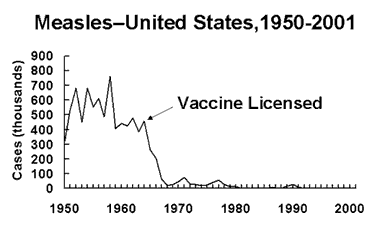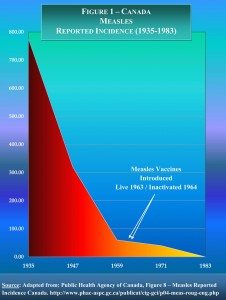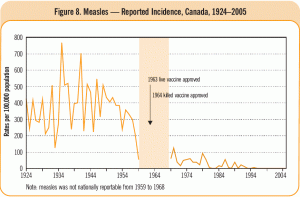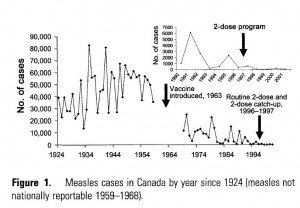If there’s one thing about the anti-vaccine movement I’ve learned over the last several years, it’s that it’s almost completely immune to evidence, science, and reason. No matter how much evidence is arrayed against it, its spokespeople always finds a way to spin, distort, or misrepresent the evidence to combat it and not have to give up the concept that vaccines cause autism. Not that this is any news to readers of this blog, but it bears repeating often. It also bears repeating and emphasizing examples of just the sort of disingenuous and even outright deceptive techniques used by promoters of anti-vaccine pseudoscience to sow fear and doubt about vaccines among parents. These arguments may seem persuasive to those who have little knowledge about science or epidemiology. Sometimes they even seemed somewhat persuasive to me; that is, at least until I actually took the time to look into them.
One example of such a myth is the claim that “vaccines didn’t save us,” also sometimes going under the claim that “vaccines don’t work.” The anti-vaccine website Vaccine Liberation has a large set of graphs purporting to show that the death rates of several vaccine-preventable diseases, including whooping cough, diphtheria, measles, and polio were falling before the vaccines for each disease were introduced. The the article quotes Andrew Weil:
Scientific medicine has taken credit it does not deserve for some advances in health. Most people believe that victory over the infectious diseases of the last century came with the invention of immunisations. In fact, cholera, typhoid, tetanus, diphtheria and whooping cough, etc, were in decline before vaccines for them became available – the result of better methods of sanitation, sewage disposal, and distribution of food and water.
Bill Maher has said similar things about vaccines, and the “vaccines didn’t save us” gambit has become a staple of anti-vaccine websites. For example, one particularly ignorant blogger (URL Removed – Malware -webmaster) wrote:
The mythology surrounding vaccines is still pervasive, the majority of the population still believes, in faith like fashion, that vaccines are the first line of defense against disease. The true story is that nutrition and psychological/emotional health are the first line of defense against disease.
Vaccines are a concoction of chemical adjuvants and preservatives coupled with virus fragments and have clearly been implicated in the astounding rise in neurological disorders around the world, yet the ‘popular’ media has embedded itself as a spokesperson for the pharmaceutical cartel and simply does not report in any responsible way the real situation.
Ah, yes, the “toxins” gambit! Of course, it is true that better sanitation is a good thing and has decreased the rate of transmission of some diseases for which sanitation can do so, many infectious diseases are transmitted person-to-person through the air from aerosolized drops of saliva from coughs and sneezes or from being deposited on objects that people touch frequently, like doorknobs and other fomites.
The “vaccines didn’t save us” strategy is a distortion, as I will show. The best way to demonstrate this is to go on to the very first website that currently shows up on a Google search for “vaccines didn’t save us.” Although the post is from November, it’s the main post that’s been spreading this lie since then. Entitled Proof That Vaccines Didn’t Save Us, it’s one of the most breathtakingly spectacularly intellectually dishonest bits of anti-vaccine propaganda that I’ve ever seen. I say that not because it uses a common anti-vaccine distortion, but rather because it ups the ante by adding a new one clearly designed to address the criticism of the old one. That new distortion hides it in plain sight, too, which is why I have to give the blogger props for sheer chutzpah. Actually, I have to give some backhanded kudos to the person who devised the graphs used in this post, Raymond Obomsawin, PhD. They represent the classic anti-vaccine lie, combined with some very clever cherry picking. I won’t take them all on in this post. Maybe I’ll take some of them on in a future post. In the meantime, what I will do is to take on the first several, because they represent a common anti-vaccine theme that is very similar to the one sounded by the this disingenuous post.
In fact, let’s look at the Vaccination Library claims first. Notice that there are six graphs, four of which are for vaccine-preventable diseases for which widespread vaccination was undertaken, two for which it was not. All of them show decreasing death rates from various diseases. Wow! It seems like slam dunk evidence, doesn’t it? Vaccines didn’t save us! After all, death rates were declining years before the vaccine, and they were declining for the diseases that didn’t even need a vaccine!
Death rates.
Here’s the problem. It’s not surprising that death rates were declining before introduction of the vaccines. Medicine was improving. More importantly, supportive care was improving. For example, take the case of polio. Before the introduction of the iron lung and its widespread use, for example, if a polio patient developed paralysis of the respiratory muscles, he would almost certainly die. The iron lung allowed such patients to live. Some even survived in an iron lung for decades. No doubt improved nutrition also played a role as well. However, if you want to get an idea of the impact of vaccines on infectious disease, take a look at this graph from the CDC of measles incidence, not death rates:
Similar results were seen most recently from several other vaccines, including the Haemophilus influenza type B vaccine, as the CDC points out:
Hib vaccine is another good example, because Hib disease was prevalent until just a few years ago, when conjugate vaccines that can be used for infants were finally developed. (The polysaccharide vaccine previously available could not be used for infants, in whom most cases of the disease were occurring.) Since sanitation is not better now than it was in 1990, it is hard to attribute the virtual disappearance of Haemophilus influenzae disease in children in recent years (from an estimated 20,000 cases a year to 1,419 cases in 1993, and dropping) to anything other than the vaccine.
In the post to which I referred, the most intellectually dishonest graph is this one:
Note how this graph, unlike all the other graphs used to make the claim that “vaccines didn’t save us” actually uses incidence data, in this case from Canada from 1935 to 1983. I was immediately suspicious of this graph, though. The reason should be obvious; the decline in measles incidence is far too smooth. Measles incidence typically varies greatly from year to year. Fortunately, in his chutzpah, Obomsawin included a link to the actual source of the graph. Naturally, I couldn’t resist checking it out, and I found that the link leads to the Canadian Immunization Guide section on the measles vaccine. And this is the actual graph from which Obomsawin allegedly extracted his data:
Note how Obomsawin left out a section of ten years when measles was not nationally reportable. Also note how he has, to be charitable, cherry picked the years to produce the impression of a smoothly declining measles incidence from 1935 to 1959. As I said, it doesn’t get much more intellectually dishonest than that. But it’s even worse than that. The graph above still gives the impression that measles incidence was falling before the ten years for which there is no data. Steve Novella points out that there is a better version of the graph in this reference, and he was kind enough to send it to me, given that, for whatever reason, my university doesn’t have a subscription to the relevant journal:
Note how this graph looks at raw case numbers and shows 40,000 cases of measles in Canada the year before the ten year interruption in the data. All in all, it’s a much clearer representation of the data than the first graph, showing a clear drop that occurred during the ten year period, in the middle of which the measles vaccine was introduced. It also shows another obvious drop in measles incidence later on in the 1990s, when the two-dose measles vaccine program was started. As for why it appears that there is a steep dip in the first graph before the ten year gap, that actually appears to be an artifact. There is no data for 1959, the first year that measles was not nationally reportable in Canada, but the line appears to go to a datapoint at 1959 or 1960. My guess is that whoever made the graph decided to set the value for the beginning of the ten year gap to equal the first datapoint at the end of the ten year gap. In other words, the graph a rather poor representation of the data, and the Canadian government would do well to replace it on its website with something more like the second graph, which makes the point much more clearly.
As intellectually dishonest as Obomsawin’s graph is, this description of Obomsawin matches it:
He has produced academically and/or professionally over eighty-five (85) articles, reports, policy documents, presentations, and publications.
A search of Pubmed reveals only one peer-reviewed publication from 1978, and it’s only a commentary. In any case, apparently served as Director National Office of Health Development of the National Indian Brotherhood (AFN); Founding Chairman of NIB’s National Commission Inquiry on Indian Health; Executive Director in the California Rural Indian Health Board; Supervisor of Native Curriculum, Government of the Yukon Territory; and Evaluation Manager – Department of Indian and Northern Affairs Canada. None of these are scientific positions. More tellingly, he is “currently engaged with government funding as Senior Researcher relative to establishing a Public Sector Policy on Traditional Medicine in Canada.” My translation? He’s somehow managed to get a government grant to try to promote “traditional medicine” in Canada. Apparently, the Canadian government has its own problems with government money going to promote unscientific and pseudoscientific nonsense of the type that NCCAM promotes. In any case, besides Obomsawin’s disingenuous and intellectually bankrupt distortions of incidence data used to serve his apparently anti-vaccine agenda, he has no qualifications to speak of with regard to science or epidemiology that I can find.
It also turns out that Dr. Obomsawin has some other–shall we say?–unconventional beliefs as well. For instance, he is approvingly featured on that aggregator of all things quackery and pseudoscience, Whale.to, where he expresses anti-vaccine views, HIV/AIDS denialism, and admiration for Royal Rife. So what we have here is a woo-meister using cherry picked points on a graph to give a false impression that the measles vaccine was not responsible for the dramatic decline in measles incidence in Canada in the 1960s. Shocking, I know.
Another rebuttal to the idea that vaccines didn’t reduce the incidence of the diseases against which they were designed comes from the simple observation that, as vaccine uptake falls, the disease vaccinated against returns. Always. This is described by the CDC quite well:
Finally, we can look at the experiences of several developed countries after they let their immunization levels drop. Three countries – Great Britain, Sweden, and Japan – cut back the use of pertussis vaccine because of fear about the vaccine. The effect was dramatic and immediate. In Great Britain, a drop in pertussis vaccination in 1974 was followed by an epidemic of more than 100,000 cases of pertussis and 36 deaths by 1978. In Japan, around the same time, a drop in vaccination rates from 70% to 20%-40% led to a jump in pertussis from 393 cases and no deaths in 1974 to 13,000 cases and 41 deaths in 1979. In Sweden, the annual incidence rate of pertussis per 100,000 children 0-6 years of age increased from 700 cases in 1981 to 3,200 in 1985. It seems clear from these experiences that not only would diseases not be disappearing without vaccines, but if we were to stop vaccinating, they would come back.
The United Kingdom is an excellent illustration of this trend. Back in the mid-1990s, it declared measles as under control, thanks to the MMR vaccine. Then came Andrew Wakefield in 1998 with his trial lawyer-funded, incompetent, and possibly even fraudulent study claiming to link the MMR vaccine to “autistic enterocolitis,’ and a credulous, sensationalistic British press to spread his message that the MMR vaccine causes autism. The result was that measles came roaring back in the U.K. to the point that two years ago measles was declared endemic again there.
The Vaccine Liberation graphs and the even more deceptive graphs produced by “Dr.” Obomsawin to claim that vaccine-preventable diseases were already plummeting before the introduction of the relevant vaccines are typical of anti-vaccine arguments. First, they contain enough of a grain of truth to them to sound plausible. After all, better nutrition and better sanitation have in general contributed to better health and contributed to a decreasing toll from various infectious diseases. But they were not enough. Indeed, part of the reason we vaccinated against some diseases is because sanitation wasn’t enough. Was sanitation so much worse in the late 1980s before the Hib vaccine was introduced than it is now? No. Was it probably even that much worse in the 1960s, when the measles vaccine was introduced? Probably not. Yet, such is the myth that the anti-vaccine movement would have parents believe. Such is the intellectually dishonest nonsense they promote.
Why do they do this? J.B. Handley himself has told us why: To bring the U.S. vaccine program to its knees. Or the U.K. program. Or whatever program where the anti-vaccine program has taken hold. The reason is that, no matter how much science says it isn’t, to the anti-vaccine activist, it’s first and foremost always all about the vaccines.




